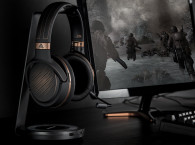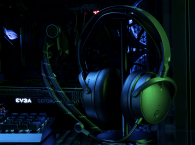High-end planar magnetic headphone manufacturer Audeze broke out of the mold with the Mobius: a wireless Bluetooth headphone capable of LDAC high-resolution playback, virtualized surround sound with built-in head-tracking, and a number of surprises Audeze continues to invent. In his review, Luke McCready shares what he learned about the fantastic Audeze Mobius Headphones, explores what this headphone can do, the use-cases for its unique features, and the limitations of this boldly conceived product. A great overview of a very sophisticated platform to which Audeze keeps adding new features.
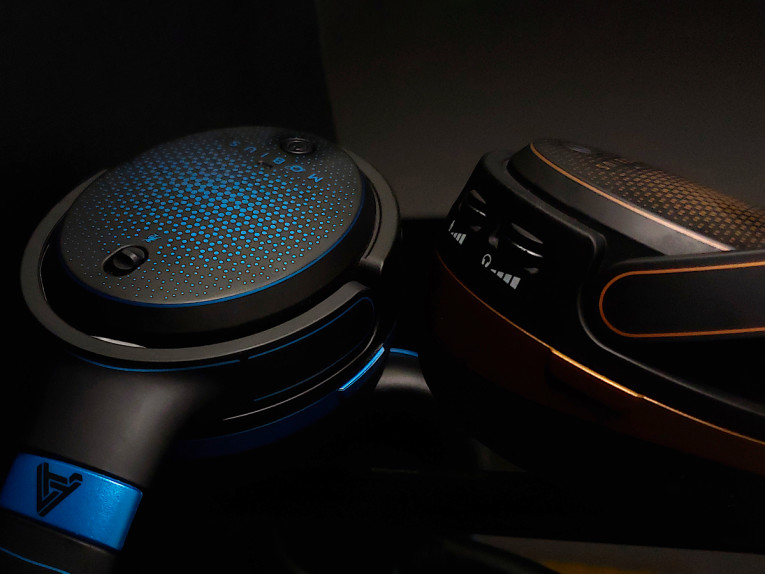
Sometimes a fascinating product passes right underneath our noses because we don’t look closely enough to see it’s potential. I can’t think of a better example than the often misunderstood Audeze Mobius, an over-the-head pair of surround headphones generally marketed toward gamers. Many reviewers explored its form factor, sound quality, and accessories. But Mobius aims to be a platform for creatives and professionals as well, and is chock-full of unique features and untapped potential.
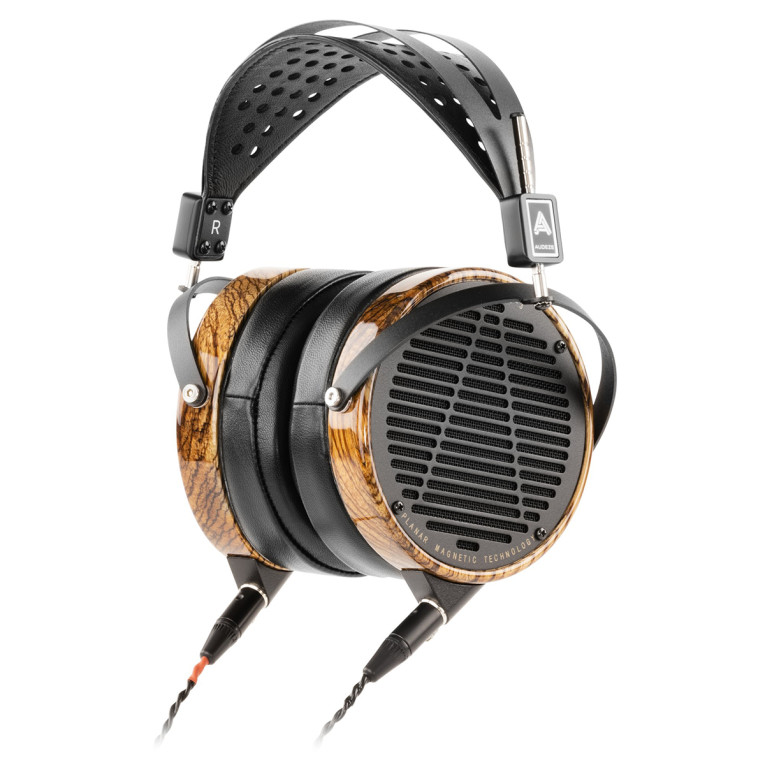
Audeze (pronounced like “odyssey”) is a high-end headphone company based out of Southern California; founded in 2008. I got the chance to interview Audeze CEO and co-founder Sankar Thiagasamudram, who shared how he and a friend met an aerospace materials engineer with a film perfect for planar magnetic drivers. And from an Orange County, CA, garage, Audeze grew into a company producing top-quality headphones widely respected in the audiophile community.
All Audeze headphones, from the bottom to the top of its product stack and even the in-ear models, use planar magnetic drivers, consisting of an extremely thin film with electrical traces sandwiched between two arrays of rare earth magnets. Because the driver is so light, in theory, planar magnetic drivers have excellent transient response and low distortion.
Thiagasamudram takes pride in the development and manufacture of Audeze headphones. “All our transducers are designed and manufactured in-house by our R&D team.” I’ve had the pleasure of listening to the LCD-3, a $2,000 pair of over-the-ear headphones (see Photo 1), and I found them exceptional. The Audeze over-the-ear lineup runs from the $400 Mobius to $4,000.
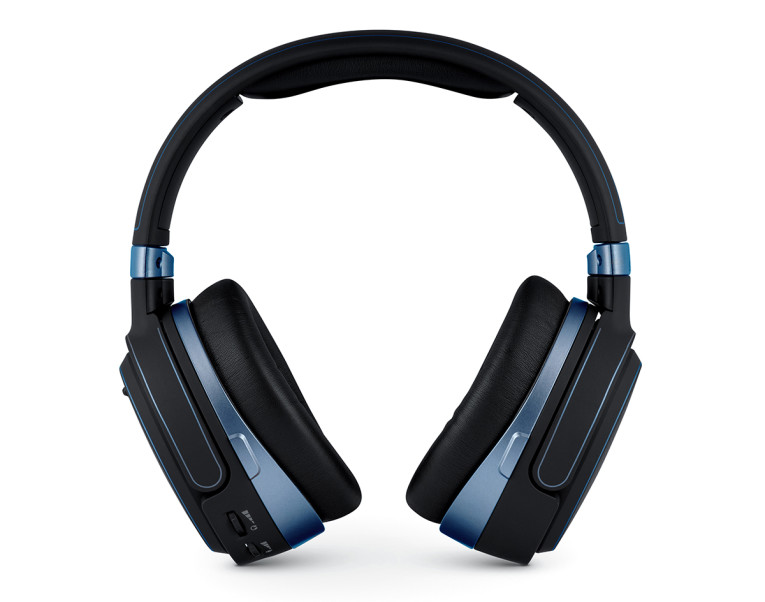
Mobius is the most unique product Audeze has ever brought to market: it not only packs planar magnetic drivers into a wireless Bluetooth headset, a very rare design choice, but it goes all-in on software-simulated surround sound, a feature at the very heart of Mobius (see Photo 2).
Thiagasamudram shared information about his history with Harvey Landy of NBCUniversal, who oversees digital delivery of movies to streaming providers. Landy’s team struggled to format and quality-check the numerous versions of each movie required for varying languages, subtitles, and video formats. “In early 2016, Landy knew that there was a need for change in their workflow with 5.1 and 7.1 deliverables becoming the norm,” Thiagasamudram said. “We reached out to Waves for help with 3D audio emulation.” And Mobius was born as a tool to help post-production houses expeditiously perform quality control (QC) checks on movies.
And the vision for Mobius evolved: if a product is designed to excel in virtual surround, gamers become an obvious market. Mobius was fitted with an optional microphone boom for teammate communication in multiplayer gaming. As gamers are consumers, wireless Bluetooth connection becomes a compelling convenience. To appeal to the audio enthusiast interested in wireless planar magnetic headphones, Mobius includes a Bluetooth 5.0 radio and support for Sony’s LDAC, a high-quality codec with the ability to adjust bit-depth per frequency band of audio. “We wanted to make sure that the Bluetooth experience on Mobius was very close to the wired performance,” Thiagasamudram said. “LDAC can go up to 96 kHz over Bluetooth, so we used LDAC.”
Even though Audeze is an established company, it opted to crowdfund the launch of Mobius on Indiegogo. I spoke with Jaren Cloud, Marketing Manager of Audeze, who shared why: “Not only was Mobius targeting a completely new market for us — gamers — but it was also the first product of its kind... Indiegogo gave us a platform to reach a lot of new customers and to gauge how many units would be needed.”
Cloud was excited. “Mobius can do a lot of things that other headphones can’t: onboard multichannel processing, head-related transfer function (HRTF) with multiple 3D modes, firmware updates that expand functionality—the list goes on.” And Audeze has yet another surprise in store.
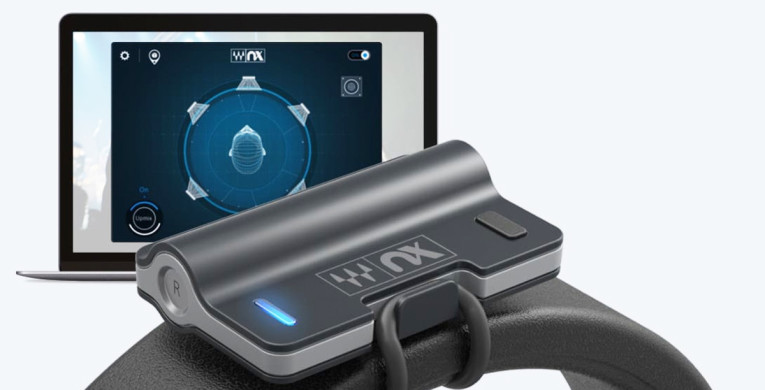
Waves Audio, a software developer specializing in mixing plug-ins for studio and live sound, launched a Kickstarter campaign in 2016 with the aim of “3D audio on any headphones.” The company designed Nx Virtual Mix Room, a plug-in to virtualize stereo and surround mixing within an acoustically treated environment for the headphones you already own. Waves designed the Nx plug-in to combine with its Nx Head Tracker, a Bluetooth device to attach to the bridge of a user’s headphones (see Figure 1). Using Nx Virtual Mix Room, the Nx Head Tracker follows the position and orientation of the wearer’s head along multiple axes: when you turn your head left, the soundscape stays fixed, seeming to come from your right.
Audeze partnered with Waves to incorporate head-tracking directly into Mobius without mounting a separate, battery-reliant device to the headphones. Head-tracking could be useful not only to audio engineers working to mix surround material on headphones, but also movie watchers and gamers looking for extra realism in their entertainment.
“Head-tracking is handled by a built-in gyroscope and accelerometer,” Cloud said. “This is the exact same technology found inside the Waves NX Head Tracker. It enhances the realism of the out-of-head emulation, which is critical when using Mobius as a tool for any kind of multichannel or spatial audio production.”
Thiagasamudram added, “We work very closely together with Waves, and not just on the management level. Our developers also work closely with theirs to make sure the user experience is seamless.” Head Gestures, another Mobius first, utilizes head-tracking to turn head tilts and nods into the hotkeys of your choosing. It works well, though I imagine a gamer in need of more controls would prefer a mouse with macro buttons. Cloud said, “Head Gestures can also be used as a supplemental tool for gamers with disabilities, which is an application that is of particular interest to us.” I have a friend with cerebral palsy that enjoys gaming but struggles to play with excellence as his hands lack coordination. Mobius’s Head Gestures could be a valuable tool for him and others like him.

But quality headphones are more than just tech. Thiagasamudram shared on the design of the drivers: “Our goal was to create a transducer that would offer the maximum efficiency and output for a given headphone size.” The design team opted on a single 100 mm planar magnetic driver per ear cup (see Photo 3). “We wanted a very linear transducer that can reproduce low frequencies down to 20 Hz with essentially no dipole drop off,” he said.
With surround sound headphones, there are two paths one can take: true surround headphones pack many small drivers around each ear, whereas virtual surround headphones use one driver per earcup and simulate surround sound with processing. I probed on the decision to implement virtual surround, and Thiagasamudram said, “With either approach, you are trying to reproduce very small changes in level, phase, and frequencies to convince your brain you are hearing audio from outside your head. Our opinion is that it’s hard to achieve with multiple drivers per ear since it is very difficult to produce the many transducers within tolerance levels.” Also, scaling becomes an issue.
“With 7.1.4 being widely used in the field, it’s not practical to cram 12 speakers inside a headphone. Using virtual surround allows us to easily implement a scalable solution.”
I asked what makes planar magnetic drivers so special. “They offer full range reproduction with very low distortion,” Thiagasamudram answered. “With very thin diaphragms, the impulse response is very fast and clean. We add a lot of digital signal processing (DSP) for 3D emulation on top, and since the planar drivers do not distort even when you add significant changes, they are ideally suited for these applications.”
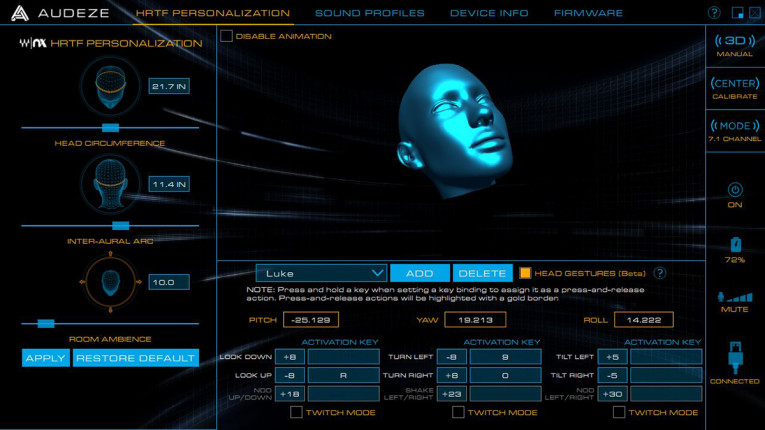
AudezeHQ
AudezeHQ is the free desktop software counterpart to Mobius, and its primary function is to customize HRTF, the processing that aims to mimic the intricacies of locationality. AudezeHQ includes adjustments for head circumference and inter-aural arc, and artificial room ambiance that’s adjustable to taste (see Figure 2).
When Mobius is plugged into a computer via USB, AudezeHQ includes modes for receiving standard stereo, hi-res stereo, and 7.1 surround. Because Bluetooth doesn’t support multichannel audio, a USB connection is required to listen to surround content.
Curiously, for a product with professional production in mind, sample rates are not adjustable — stereo mode is locked to 48 kHz/16-bit, surround mode is locked to 48 kHz/24-bit, and hi-res mode is locked to 96 kHz/24-bit.
AudezeHQ includes Sound Profiles to tailor the EQ of the headphones to individual tastes from the eight provided presets, including choices such as Ballistics, Racing, and Warm. The changes are subtle, which is appreciated. “We don’t believe in extreme frequency boosts,” Cloud said. He also confirmed that the profiles are limited to EQ changes without further DSP applied. To my ears, Default sounds the most natural, though I’d love to see some custom EQ options to manually tailor the sound.
But it’s the Mobius headphones themselves that are something special, not AudezeHQ. I asked Cloud about where the virtualization happens, and he said, “All surround sound, spatialization, and tracking functions are performed inside the headphones themselves.”
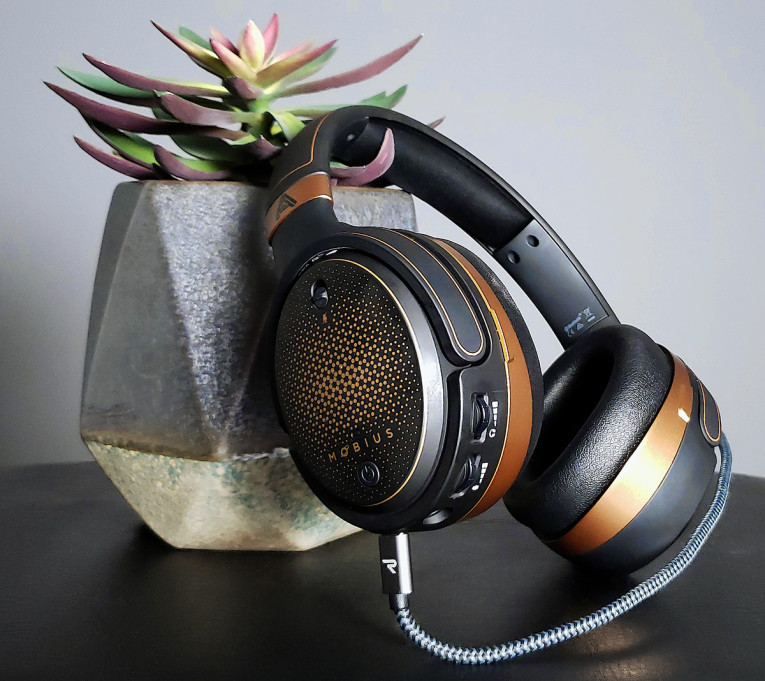
Mobius, designed to be listened to via USB, is an excellent headphone that’s neutral, exacting, and full. Compared to my favored AKG K702, Mobius has a noticeably flatter frequency response — as it should: Audeze admits heavy DSP in tuning the drivers. A fairer test is Mobius against the K702 corrected by Sonarworks True-Fi, a consumer-oriented program that compensates for headphone frequency aberrations. Relative to the Mobius, my K702 with True-Fi sounds more spacious and articulate, though it’s benefitting from the advantages of open-backed headphones.
Mobius adds a slight forcefulness to midrange frequencies that can be overbearing on occasion, and it lacks a certain texture and breathiness heard on a singer’s voice. That said, Mobius sounds more natural and detailed than most headphones, and the K702 with True-Fi makes for very tough competition. Compared to the closed-back Sennheiser HD 280 Pro, the Mobius sounds significantly more precise, spacious, and with soundstage subtlety beyond left, right, and center. True-Fi helps close the gap with the HD 280 Pro, though it can’t add that spaciousness or keep certain midrange frequencies from biting. I feel these are fair comparisons: though Mobius costs more, it also includes far more hardware along with software capability.
However, there are more options than just USB listening. I used my mid-level DAC and headphone amp to feed the analog input of the Mobius. The sound was not bad, but perhaps suffering from some distortion on the input side of the Mobius. Put simply, USB performance sounds like a more expensive headphone relative to analog-in performance (see Photo 4).
Thiagasamudram achieved his goal, as Bluetooth sounds similar to wired USB performance. I hear a little more detail and a little greater bass response over USB, but the performance of properly configured Bluetooth is genuinely impressive.
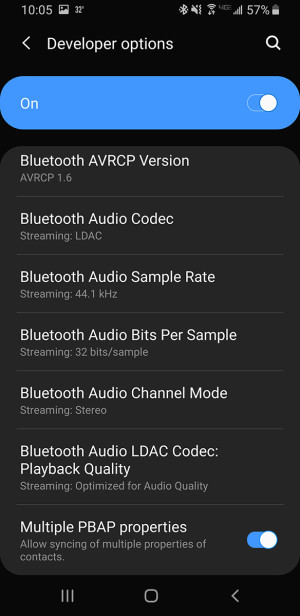
in Android’s hidden Developer Options.
44.1 kHz at 990 kbps sounds very similar
to wired USB performance.
LDAC Performance
Does the LDAC Bluetooth codec make a difference? Certainly, though it takes a bit to configure as you need to enable Android’s Developer Options to access LDAC settings. LDAC is not supported on iPhones. Many devices offer SBC and AAC Bluetooth codecs. Enabling LDAC at 44.1 kHz sounds slightly better than AAC and noticeably better than SBC.
The difference is in the grit and texture of sound that gets lost in compression. But things go awry when I switch to a 96kHz LDAC stream: panning sounds more dramatic, there’s an audible low/mid-frequency bloat, and vocals sound less centered and focused. I experienced this across two media players and a streaming service, testing with uncompressed hi-res files, uncompressed CD-quality files, and MP3 streaming. Hi-res sample rates over LDAC are far from purist: 44.1 kHz LDAC sounds significantly closer to a wired connection than 96 kHz LDAC. What clearly sounds like additional processing could be due to how Mobius’s DSP is programmed to handle each codec, or more likely, the LDAC encoder in my Galaxy s9 phone. Regardless, locking LDAC to 990 kbps and 44.1 kHz ensures exceptional performance (see Figure 3).
On the topic of LDAC, Sony’s “hi-res” is not exactly true hi-res, connection speeds often drop from the top tier of 990 kbps, and that frequency response and noise floor suffer as the connection speed drops. Admittedly, 330 kbps sounds pretty brittle, but when forcing 990 kbps, I experienced dropouts only rarely with my Samsung Galaxy s9 in my pocket or a room or two away. All things considered, LDAC allows for above-CD-quality file playback, and the experience of CD-quality content with LDAC is excellent: imperfect technologies can still reap benefits.
Configuring the Surround Modes
There are multiple modes for 3D audio within Mobius, and you cycle through them with the physical button labeled “3D.” The first two modes are variations on surround emulation with head-tracking, the third skips the head-tracking, and the fourth disables 3D audio, treating Mobius as stereo headphones even in 7.1 mode. Thiagasamudram clarified, “When 3D is switched off, we do a fold-down without any 3D emulation.”
The first time I twisted in my desk chair with 3D audio on, I was sure I had left my desktop speakers playing in addition to the headphones. The head-tracking and Mobius’s ability to localize sounds in the stereo spectrum is effective, but for it to work there has to be some room emulation enabled. The effect is less realistic as you spin all the way around: audio imaged to the rear sounds very similar to audio imaged to the front, just with a lower source-to-reverb ratio and rolled-off highs. I don’t find Mobius’s rear surround emulation convincing.
I measured my head and dialed the numbers into AudezeHQ. Accurate measurements do not make surround emulation more convincing, but they do make 3D modes sound more neutral. The Room Ambiance slider is adjustable. Above 40 sounds awful to my ears, 30 sounds reasonable, 20 is my preferred setting, and 0 sounds relatively studio-dry, though it makes surround emulation even less convincing: raising the slider is a trade-off in that it increases the surround emulation’s effectiveness while decreasing the desirability of the sound.
Thiagasamudram clarified, “3D is meant to spatialize the audio for you, so even with Room Ambiance turned to 0, there is still HRTF active, and the HRTF changes with your head position. Though HRTF provides clues to the directionality of sound, without room reverb, depth information will be missing, causing the image to collapse.”
Turning on any of the 3D modes adds gain, a certain harshness, a distinct lack of clarity, and artificial ambiance even with the Room Ambiance slider at zero. It takes away from the precision of good headphones and sounds noticeably more veiled and lo-fi. “With 3D off, you’re just listening to a regular pair of stereo headphones. The difference in distinction/clarity/intimacy would be akin to the difference between listening to headphones vs speakers in a dead room,” Thiagasamudram said. “One can’t create an artificial sense of space and distance without giving up some of the experience of listening to a regular pair of stereo headphones.”

Listening to surround-encoded music and concerts with 3D mode on is not convincing: I can’t decipher any surround material unless I deliberately game the system by turning 90° away from the screen with head-tracking enabled to hear front channels in one ear and surround channels in the other. Disabling 3D provides the impact and punch that music deserves - the cost of surround emulation with music is not worth the benefit.
Surround sound in movies fares slightly better on the Mobius. It’s difficult to pinpoint exactly which sounds are coming from behind, but it does add a sense of immersion (see Photo 5). Unfortunately, the sound with 3D mode on is reminiscent of down-firing TV speakers: lacking clarity, definition, and transient response. Because of this, again, I’d rather use Mobius in stereo (see Figure 4).
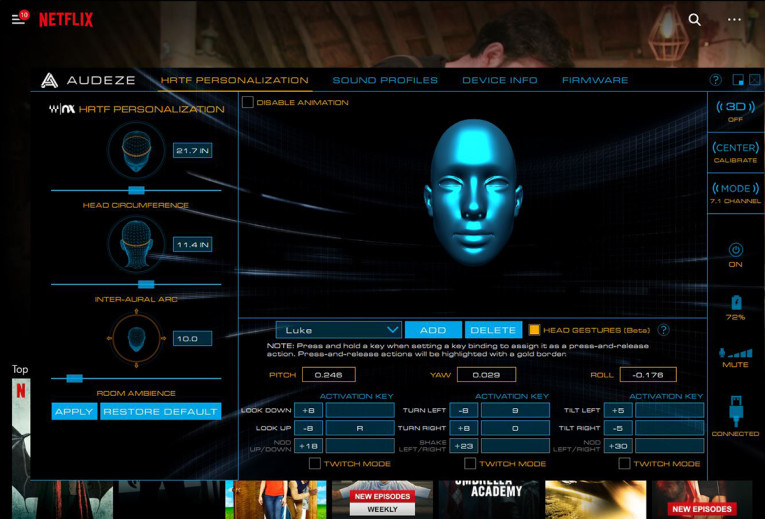
Cloud, enthusiastic about gaming (see Photo 6), said, “What I always try to emphasize to people is that head-tracking isn’t there because we expect you to constantly be turning your head when playing a game—obviously you’re not going to do that. The idea is that if you aren’t tracking your head’s movements, then you aren’t creating a convincing real-world listening simulation, because in the real world your head is constantly in motion, and that plays a major role in how your brain localizes sound.”
Maybe, but I couldn’t detect Mobius adjusting to the subtle, continuous movement of my head. I think the best use case for head-tracking in gaming is with an ultrawide monitor.
During testing, I plugged my computer into my home theater for the first time. To make the test fair, I wired up my Andrew Jones-designed Pioneer speakers: a budget but quality 5.1 system. The sound was full and dynamic, and I heard an abundance of surround content I had missed on the headphones; all of it sounding crisp and natural and distinctly surrounding me. It was so much fun that I lost track of time and just played the game. Gaming on a true surround system showed just how lacking virtualized surround headsets are relative to the real thing.

Examining the Shortcomings
One might wonder where the fault lies in the complaints we’ve collected. To be fair, we need to address each aspect individually: playback quality, the binaural renderer, and the loss of fidelity with surround emulation. I’ve already shared that the stereo sound quality of Mobius is excellent: not quite worldclass, but a fair margin better than most headphones. Playback quality isn’t the issue.
Some fault lies with the nature of binaural rendering: Acoustics are complicated. The physics of sound passing through the skull and surrounding tissues are complicated. Moreover, every human has differently shaped ears, and locationality is different for every person. “We’re accustomed to listening through our own ears and our brain is not easily fooled when a different HRTF is used,” Thiagasamudram said. “However, the use of head tracking in Mobius helps aid in our brain adjusting to the new HRTF; it does need some time.”
We may not have the technology to properly emulate surround sound on headphones in 2020. And if we do, it’s more likely to be in the form of something like the Realiser A16 by Smyth-Research, a powerful standalone surround processor that relies on exacting measurements per ear of each user. And Thiagasamudram (see Photo 7) may agree. “The best form of virtualization is making true measurements of one’s HRTF in the setup/room one wants to emulate,” he said.
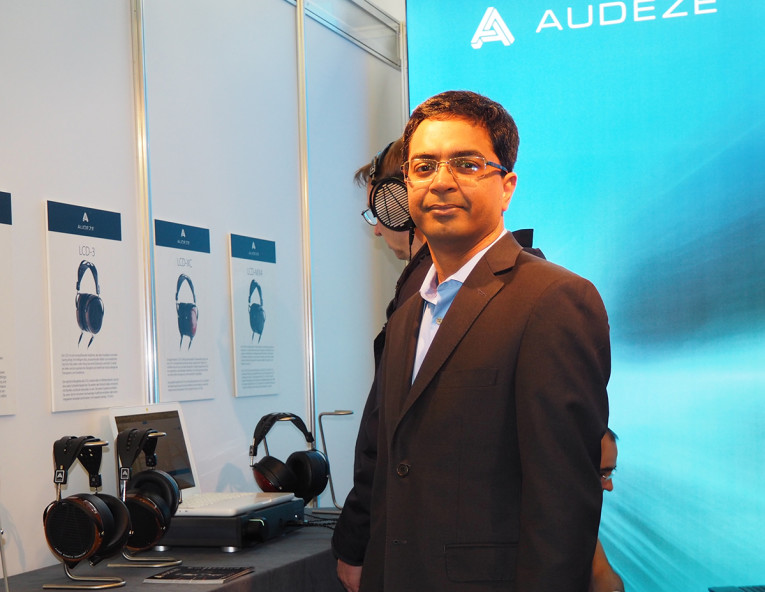
“Though it is technically possible to make such HRTF measurements, it’s not practical to do such measurements on a large scale. Moreover, using high quality, true-HRTF measured in real-time within the headphone requires memory and processing power that would not be possible to squeeze into headphones with the technology available today.”
As for the loss of fidelity, the best test was to pit Mobius’s binaural renderer against that of Waves Nx, the $10 desktop program that contains the same binaural renderer as Mobius, but to be used with any headphone (see Figure 5). I tested both renderers with Mobius. Surround emulation in Nx was not superior, but subjectively, the fidelity loss from Mobius’s 3D processing is four times worse than Nx’s processing. I can forget that Nx is active as I’m watching a movie, but I can’t forget when Mobius’s 3D mode is on.
Surround Formats and Mobius
A quick look at surround sound formats is worthwhile. In the DVD-era, channel-based sound was the only option. A studio would mix a movie’s audio into 5.1 surround, with one channel intended for one speaker.
Object-based sound, with standards like Atmos and DTS:X, allows for sound “objects” to be mixed anywhere in the room, including on the height dimension. Object-based audio is speaker-agnostic in that it doesn’t matter if you’re listening in a 5.1.2 home theater, a 29.4.18 movie theater, or on a pair of headphones: the mix leaving the studio is the same, to be interpreted by your playback device.
Scene-based sound goes even further by creating an entire sphere or “scene” of audio around the listener that could contain hundreds of sound sources. Ambisonics B-Format is becoming the standard for VR games and 360° video, as it’s able to coarsely create the sphere of sound using just four audio channels. And fourth-order Ambisonics, included in the MPEG-H standard, requires at least 25 channels of audio to create and results in a significantly more intricate sphere of audio — enough to feed up to 64 speakers.
Mobius operates on channel-based audio. There is no sensation of height, as 7.1 surround exists on the horizontal dimension. Atmos and MPEG-H support would be a nice addition to the headphone-wearing cinephile, and they’re increasingly mandatory to create rough mixes and perform QC checks for movie and TV post-production houses.
Atmos is also quite attractive to gamers, as the leading edge of games are adopting object-based sound just as they are ray-traced lighting. Lacking support for height and object- and scene-based audio, Mobius is noticeably feature-uncomplete. Still, Mobius is an evolving platform, and the decision to use virtual surround makes this a possible addition via firmware. As Thiagasamudram said, virtual surround is scalable.

Mobius was initially designed as a tool for performing surround mix QC (see Photo 8). As an engineer that works primarily in stereo, I asked Cloud if Mobius has any advantages in the stereo realm. “The head-tracking and spatialization functions of Mobius don’t really provide any dramatic benefits for stereo workflows,” he said. “It’s the surround monitoring potential of the Mobius that really makes it shine as an audio production tool.”
For my first production test, I used Mobius as the output for a 7.1 channel surround mix with numerous vocal layers panned in all directions. Using 3D with head-tracking, it was pretty fun to swivel my chair and hear each vocal layer come marginally more into focus. But the binaural rendering was unconvincing, particularly when dragging a single voice around the sound field. The 3D hit to fidelity makes Mobius sound far too skewed to create a surround mix that will translate. And significantly, Nx Virtual Mix Room performs the same emulation with a smaller sonic penalty than Mobius.
If Mobius’s production value is that its head-tracking works with Nx, it’s not making a compelling argument: Try as I might, I couldn’t get any of the Waves plugins to recognize Mobius as my head-tracker.
Google and YouTube offered no solutions, and the Audeze website only added, “Because Mobius uses the same technology that is found inside Waves’ own Nx Head-Tracker, it can route all of its head-tracking information straight to the plugin.”
For my second production test, I explored the uses for Nx Virtual Mix Room in a stereo mix session. Using Nx on every channel allows for surround panning and binaural rendering before the audio heads to the master bus. A neat trick, though lacking realism. And as the master bus is stereo, Mobius is a passive participant: a quality stereo headphone with no other useful additions.
For my third production test, I created a B-Format Ambisonics mix using Waves B360 on every track (see Figure 6), allowing me to position sounds anywhere in a sphere, including height. Like Nx, the effect was far from spell-binding. Supposing Mobius can be used for head-tracking with Waves plug-ins, it could help one create an Ambisonics mix. But again, Mobius is operating as a traditional two-channel headphone.
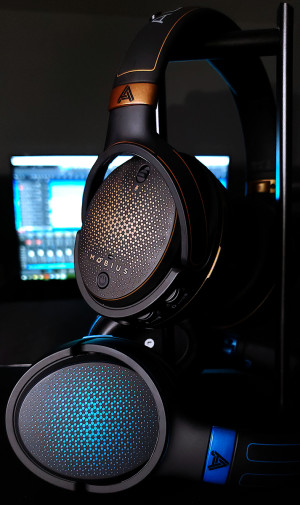
targeted professional audio production first.
Challenging the Narrative
“Mobius is starting to see some use as a tool for creators in the XR space [of virtual reality and 360° video],” Cloud said, “and I think Mobius makes the idea of spatial audio experiences a lot more accessible and relevant. Jonathan Rowden, CEO of Overworld, has been using Mobius to help with that kind of content production for over a year now.”
I struggle with the claim that Mobius is a tool for production work, XR or otherwise. Used as a 7.1 sound card, Mobius can’t play back surround content without 3D turned on. And Nx plug-ins in the DAW already offer the same binaural rendering for any headphones with a lower sonic penalty. The only advantage Mobius has for surround work over traditional stereo headphones is the built-in head tracker that won’t talk to my Waves plug-ins.
Every feature advertised in the Mobius Creator Package, from real-time monitoring of Ambisonics to FuMa/AmbiX conversion to DAW support, is referring to software from Waves, not hardware from Audeze.
Conclusion
I’m beginning to think of Mobius less as a pair of surround headphones and more as a platform, ripe for innovation and continuous improvement. Audeze’s ability to add functionality after release and its track record of doing so is reminiscent of Tesla, rolling out safety features and even acceleration and braking enhancements to its vehicles after they’ve been sold.
In May 2019, the headphones gained a new 3D mode, improved bass response, and even improved imaging. And recently, Audeze updated Mobius with an ASIO driver, aiding in bit-perfect music playback and DAW integration. “We see Mobius as a platform that continues to evolve,” Thiagasamudram said. “We get feedback from customers, and if possible, implement these changes and push them out using firmware updates.”
We’ve thoroughly covered the issues in using Mobius 3D for gaming and consuming movies and surround-encoded music. The case for Mobius as a production tool is equally weak with the possible exception of XR. And though artificial reality feels in its infancy, virtually all current VR headsets offer native head-tracking, and in many cases, body-tracking too.
I’m impressed by everything Mobius can do in theory, but it feels like an unfinished solution for a large handful of problems. Binaural rendering at a smaller sonic penalty feels very much within reach for Mobius over future updates. But in its current state, I would rather use headphones I already own and optionally use the $10 Waves Nx as a mildly-effective binaural renderer for my multi-channel PC content.
As much as I want Mobius to be more, I can only recommend it for the standard use-cases of listening to stereo content over wired USB and wireless 44.1 kHz LDAC (see Photo 9). And for those tasks, Mobius genuinely excels. Truly, a single major improvement would create a large market for Mobius.
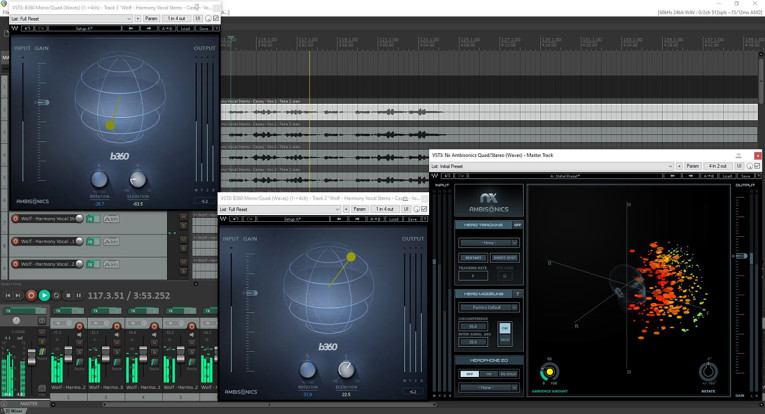
If Atmos and MPEG-H are added and nothing else, Mobius would be useable for QC checks on modern film projects. If 3D modes can operate at a lower cost to fidelity and nothing else, Mobius becomes the gold-standard of gaming headsets. And if surround emulation improves and nothing else, Mobius would become the must-have tool for surround mixing engineers, hobbyists and professionals alike.
There’s good news and bad news on those fronts. When I asked if Atmos support is possible, Thiagasamudram simply stated, “The current version of Mobius will not support Atmos. The processor is quite powerful, but there is no easy way to send object-based audio over USB. But doing it on the software side is possible even today.” As 7.1 mode requires a USB connection to a computer, I think an AudezeHQ-based software decode of Atmos and MPEG-H would be perfectly convenient. The emulation could happen on the software side with the binaural render sent as a stereo signal to the headphones.
I asked if Mobius will ever part from the Wave’s Nx renderer, perhaps because Audeze is cooking up something more advanced. “No,” he said. “Mobius models will use Nx. But that’s not to say Waves’ emulation might not improve over time." Thiagasamudram later shared, “At NAMM, we will be showing a new plugin for our (non-Mobius) headphones that uses machine-learning HRTF to emulate 3D audio.”
That could be very compelling.
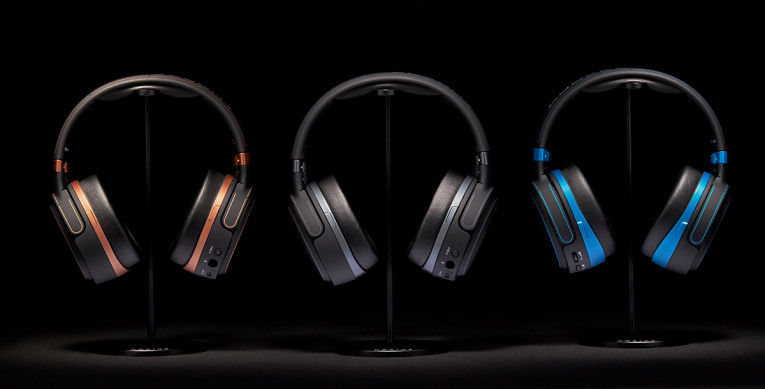
Fortunately, Mobius is only the beginning, as Audeze is working on other high-tech projects beyond traditional, analog headphones. “2020 will perhaps be the busiest year for us,” Thiagasamudram said. “Some of our new projects will be radical departures for Audeze. We plan to do an event early in Q2 showing all the products.” If Mobius ever grows to feature more convincing surround emulation with greater fidelity, even to include object- and scene-based decoding via a host PC, it would be a truly incredible product. But even if it doesn’t, Mobius appears to be just the first such radical infusion of hi-fi and high-tech from Audeze, and future products are only going to build beyond this innovative platform. aX
This article was originally published in audioXpress, March 2020.
About the Author
Luke McCready is an audio engineer, a technical writer, and a music lover based out of Denver, CO. He graduated with a degree in audio engineering from North Central University with a passion for audio and a fascination for speaker setup and acoustic treatment.
Resources
A16 REALISER, Smyth-Research, smyth-research.com
“Ambisonics Explained: A Guide for Sound Engineers,” Waves, October 2017,
www.waves.com/ambisonics-explained-guide-for-sound-engineers
Ambisonic Plugin Generation, MathWorks,
www.mathworks.com/help/audio/examples/ambisonic-plugingeneration.html
Audeze, www.audeze.com
Audeze Mobius, Indiegogo, www.indiegogo.com/projects/mobius-immersive-cinematic-3d-audio-headphone#
LDAC, Sony, www.sony.net/Products/LDAC
“Scene Based Audio: A Novel Paradigm for Immersive and Interactive Audio User Experience, Qualcomm snapdragon, 2015,
www.qualcomm.com/media/documents/files/scene-basedaudio-for-mpeg-h-whitepaper.pdf
Waves Nx—3D Audio on Any Headphones, Kickstarter, October 2016,
www.kickstarter.com/projects/waves/waves-nx-3d-audio-on-any-headphones
Sources
AKG K702 open-back headphones - Harman International Industries | www.akg.com
Audio-gd Fun integrated DAC, preamp, and headphone amplifier | www.audio-gd.com
Denon AVR-X1500H receiver | usa.denon.com
Pioneer SP-FS51-LR floor-standing speakers and matching surround set | global.pioneer
Reaper 6 DAW | www.reaper.fm
Sennheiser | www.sennheiser.com
Studio One DAW | www.presonus.com



